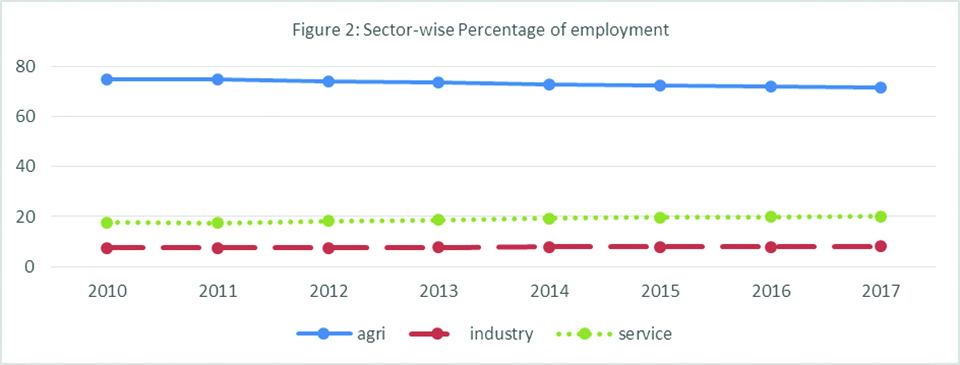
In addition to investment in primary sector, government needs to invest in service and industrial sectors to attain sustainable growth
The growth projection of 5.89 percent for the current fiscal year unveiled by Central Bureau of Statistics (CBS) in April offers silver lining at the backdrop of the bleak economic scenario painted by the ‘White paper’ in March.
As per the information on National Accounts provided by CBS, the growth is largely driven by construction activities and the service sector. The service sector will continue to be the major contributor to GDP followed by the agriculture and industrial sector. The projected growth in primary sector mainly agrarian is not encouraging—it is recorded as low as 2.7 percent. Meanwhile, the industrial sector is expected to grow through the increased post-earthquake reconstruction activities.
In-depth understanding of the sector-wise contribution to overall GDP over the last decades reveals that service sector has been the major contributor to nation’s GDP followed by agriculture (primary) and industry (secondary) over the long period (see figure 1). Nevertheless, the growth pattern in these sectors has not been encouraging over these years. This is definitely worrisome.
Global trend
FIR lodged as lights on Ayodhya’s Ram Path and Bhakti Path go m...

The sustainability of 5.89 percent needs to be tested on a global economic scenario. Where does the growth story of Nepal stand out in the global outlook?
While majority of classic literature and normal textbook economics have argued for several years that economic growth is associated with the manufacturing sector, this is not the case in Nepal until today. In fact, there has been higher contribution from the service sector, quite contrary to conventional growth path. The countries that have achieved substantial income convergence toward more developed economies since the 1960s normally experienced a robust increase in manufacturing, employment and exports.
The East Asian Tigers are the classic illustration of the success stories about how the traditional path to growth goes through industrialization from agriculture through the manufacturing and later to services.
Surprisingly, the higher contribution from service sector is not a peculiar trend. The recent report of World Economic Outlook-2018 by International Monetary Fund highlighted that the share of service sector in overall contribution has risen almost everywhere, reflecting a shift away from manufacturing base in advanced economies and mostly a shift from agriculture in developing economies.
The share of services in global employment has increased by about 16 percentage points since the 1970s. Moreover, average productivity growth in services in many developing economies, including China, India, and some in sub-Saharan African economies, has recently exceeded that of manufacturing. India also appears to be moving away from the traditional path by globalizing through service-led activities which is mainly aided by information technology and outsourcing.
Hence, the service sector-led growth has been a ‘new and buzzing game’ among the pundits and scholars in development discourse. Phenomenon of service sector-led growth has been the striking feature in recent phenomena of structural transformation.
Boosting growth
In terms of contribution to GDP and employment, service sector is now contributing more than manufacturing in both low and high income countries. This has led to an emerging debate on whether service or manufacturing will be be the main source of growth for developing countries like Nepal.
The growth in the service sector has not been so impressive and progressive in case of Nepal. More than 60 percent of the population is still engaged in agrarian sector which is in a dismal state for almost two decades (see figure 2). Despite higher contribution from the service sector (approximately more than 50 percent in the recent years, see figure 1), the stagnation over the last decade has not enabled this sector to absorb the excess labor which has resulted in acute manpower-drain from the country. The service sector has been only able to absorb 20 percent of the total population over the decades.
Investment in the agriculture sector will certainly boost its productivity but since it is less elastic in nature compared to other sector, overall GDP growth may saturate at a certain point. Therefore, in addition to the investment in primary sector, the government needs to invest in service and industrial sectors to attain sustainable growth. It needs to channelize the investment in hydro-electricity which has been the comparative advantage sector where we have often failed to realize its full potential.
Growth in industrial sector has been less than 20 percent over the last decades. The completion and additional investment in hydro project may stir up industrial sector in the economy with the creation of additional employment opportunities. Besides, tourism has been the favorable sector which can facilitate the growth-space for the service sector in coming years.
Timely completion of Pokhara and Bhairahawa airport projects and extension of national roadways along with other tourism-related development activities is likely to expand growth in hotel, transport and communications services.
Contribution from hotels and restaurants has been less than five percent over the decades suggesting the wide scope of growth in overall service sector in the future. Thus it is highly likely that the service sector and industrial sector will grow at greater pace in coming years provided that the government provides much needed ‘big push’.
It will have positive spill-over effects in the economy. Prioritizing the heads for capital expenditure in this line can be a decisive factor in the upcoming budget to spur long-term growth in the economy.
It is not necessary for us to have one sector-led growth policy in a globalizing world. We need broader agenda on growth. We need not be a one-trick pony. We can digress from the “one size fits all” growth recipe. It is better to have a right mix of growth in each sector to spur sustainable growth.
The author is a consultant at National Institute of Public Finance and Policy, New Delhi





































